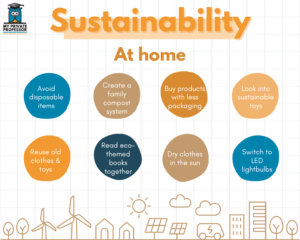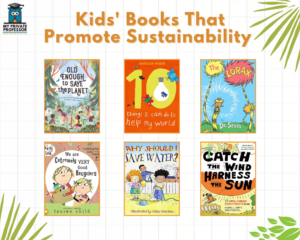Students don’t live in complete bubbles. When they’re not in school, they hear about what’s happening in the world around them. So it’s pretty likely that they’re aware that our environment is constantly facing challenges such as climate change and pollution.
It’s important to remember that it can be difficult—maybe even impossible—for students to just tune everything out and hone in their focus on what they’re learning on any given day. 
But by giving students knowledge and tools to be part of the solution, educators can empower students. Additionally, when students have more insight to how they can help better the environment and their school’s sustainability efforts, they’ll feel less helpless about the issue. And as a result, they’ll be less distracted and more able to stay focused and present in class.
Even more, it’s important to consider how environmental issues have direct impacts on children’s learning.
For instance, bad air quality can lead to increased student absences, lower concentration, and increased rates of asthma among students.
Increase accessibility to recycling bins
Even if you tell students to recycle, what will help more is putting the recycling bins right under their noses, literally. By placing more recycling bins around school, and in more accessible locations, you make it easier for students to recycle. Contrastingly, when students have to exert more effort (for instance, in finding recycling bins), they are less likely to follow through.
Create a sustainable school garden
Starting a community garden at school is a great way for students to learn more about the food they eat and the environment around them. Rather than just hearing you speak about it, a hands-on, ongoing project like this can inspire students to learn more about various sustainability efforts and hopefully, take more initiative. Additionally, you can take this opportunity to teach students more about health and nutrition—and specifically, about how healthy eating impacts students’ learning.
 Here’s something else: spending time in nature can actually benefit students in some pretty major ways. And developing a school garden is a great way to encourage this nature time.
Here’s something else: spending time in nature can actually benefit students in some pretty major ways. And developing a school garden is a great way to encourage this nature time.
Research has found an association with just TWO hours of spending time in nature weekly and better health and well-being. And when students have better physical and mental health, they’re inevitably more equipped to focus and retain class information. In fact, research has found a link between exposure to the outdoors and higher academic performance.
Implement a sustainable composting system
Rather than simply recommending that students compost at home, consider doing a compost project together, as a student-led project. When students get to see, directly, what they can do with their waste, they’ll be more likely to follow through outside of class. And when you give students creative reigns, they feel more connected to the project, are more invested and are thus more engaged and more likely to truly learn.
Reuse/repurpose through creative craft projects
Often, doing goes a lot farther than telling. That is, implementing hands-on projects that speak for themselves, is often a more valuable way to teach than by simply lecturing. If you show your students that they can create something truly beautiful out of something that they thought was garbage, you’ll open their eyes.
You can also emphasize the notion through fun events such as used book fairs, where families bring in all the books they have no use for anymore. Then, students can go home having done something meaningful for the environment and having gotten new books!
Promote sustainability accomplishments 
Whether you choose to praise students’ accomplishments around sustainability in newsletters, on social media, or during assemblies, a little praise can go a long way. When students see that their work is being seen and appreciated, they’ll be more motivated to keep working hard at their sustainability efforts. Plus, you’ll also be raising awareness about sustainability and potentially teaching others how they can do better.
Decorate the classroom with indoor plants
One study found that soil in potted plants can help clean indoor air. As it stands, poor air quality is a major issue—according to the Environmental Protection Agency, in 2022, around sixty-six million tons of pollution were emitted into the atmosphere in the U.S.
Adorning the classroom with indoor plants is a great way to not only improve the air quality in school, but also to improve students’ well-being. That is, research has pointed to a relationship between indoor plants and improvements in mental health.
A 2015 study, for instance, found that caring for indoor plants reduced both psychological and physiological stress in participants. And we know that mental health and physical health go hand in hand—so there’s a chance that exposure to indoor plants, indirectly, can help students improve their physical health.
Finally, researchers have also found that exposure to indoor plants may help people recover from mental fatigue—for students, who spend their days exerting cognitive energy, this could be incredibly beneficial.
Provide recommendations for sustainable school supplies
As a student, shopping for school supplies is one of the more fun parts of the school year! You get to decide on color schemes, whether you’ll use mechanical or traditional pencils, and a trendy bag to carry it all around in.
Suggestions for sustainable school supplies brands
Encourage parents to idle less when picking up students
Through monitoring the air at schools, Sustainable America found that while parents wait for their kids, the levels of toxins are higher.
The pickup/drop-off situation at your school may be hectic—but parents idling less (in their cars) can help reduce this chaos. More importantly, reducing the amount of car idling may significantly reduce the toxins in the air.
Encourage walking or biking to school
When students opt for walking or biking to school instead of driving, they in turn contribute to reducing traffic emissions. This is a simple yet effective way for students to help make a difference in amping up sustainability efforts—and plus, it’s a great way to get some exercise in before the school day! You can also use this as an opportunity to teach students about how physical exercise impacts academic performance.
To get students excited about this, consider making a chart where each time students bike or walk to school, they get a sticker—and maybe once they get, say, five stickers, they earn a prize. After all, competition can really encourage participation.
Final thoughts
Motivating students to think more about the planet could be more profound for them than you realize. Often, students get into a headspace where they feel somewhat lost in the sauce—and this may stem from feeling as though they don’t have a passion.
Inspiring students to care and give back to the environment may help students develop a passion. And from there, they’ll be more inclined to do more digging about all their potential passions and interests in life.
As a result, students will be more excited & motivated about life in general—and this will certainly translate to their focus, presence, and enthusiasm in the classroom.
Educating the next generation doesn’t just mean teaching students all the proper equations, grammar rules, and APUSH facts. It also means helping them become citizens who can contribute to bettering our world. And environmentalism is a major part of this!







